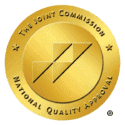To fully prepare a person for successful, long-term recovery, it is essential to address the full scope of their needs, including any co-occurring mental health concerns. This includes helping people who have been living with untreated trauma. At Sanctuary Treatment Center in Los Angeles, EMDR therapy is a vital component of care for clients who have a history of trauma.

What is EMDR Therapy?
The initialism EMDR stands for eye movement desensitization and reprocessing. This form of therapy combines rapid eye movements or other forms of bilateral stimulation (such as taps or sounds) with elements of cognitive therapy to help people overcome distress related to traumatic memories.
Francine Shapiro, Ph.D., began to develop EMDR therapy in the late 1980s. Dr. Shapiro initially called this new form of therapy Eye Movement Desensitization (EMD). In the early 1990s she changed the name to EMDR therapy to more accurately reflect the principles upon which this approach is based.
EMDR therapy in Los Angeles at Sanctuary Treatment Center is organized into the following eight phases:
- Phase 1: During this initial phase, the client and the therapist discuss the client’s history and the goals of EMDR. They also work together to identify specific traumatic memories to target during future phases.
- Phase 2: In the second phase of EMDR therapy, the client will learn techniques for self-control and stress reduction. This can help them manage their emotions between sessions, until the traumatic memory has been effectively addressed.
- Phase 3: This is when the client and the therapist will agree on which traumatic memory to focus on. The client will describe the negative feelings they experience when they recall this memory. This phase is sometimes referred to as the assessment phase, because the therapist will establish a baseline for the intensity of the client’s response to the traumatic memory. During this phase, the client will also choose a positive belief to replace their negative reaction.
- Phase 4: This phase introduces the rapid eye movements or other bilateral stimulation. The client will focus on the target memory and follow the therapist’s guidance to rapidly move their eyes from side to side. This may be repeated multiple times, with breaks to allow the client to pause, let their mind go blank, and then re-focus their attention.
- Phase 5: This is sometimes called the installation phase. During Phase 5, the therapist will encourage the client to apply the positive belief from Phase 3 when recalling the traumatic memory. Eye movements and/or bilateral stimulation will continue during this phase.
- Phase 6: At this time, the client will “scan” their body to identify remaining physical stress or tension related to the traumatic memory. If they identify any continuing negative physical responses, they may engage in additional therapeutic activities to alleviate this distress.
- Phase 7: To bring closure to the session, the therapist will remind the client of the self-control and stress-management techniques they discussed during Phase 2. This is especially important in cases where the distress the client experiences while recalling the traumatic memory has not been fully resolved by the end of the EMDR therapy session.
- Phase 8: This phase occurs at the beginning of the next session. This is a time for the client and therapist to review the client’s progress to date and identify additional sources of emotional distress that may need to be addressed during the new session or at a later date.
Clients will progress through several phases during a typical EMDR therapy session. The number of sessions they participate in will be determined by their progress and continued need.
What Does Our Los Angeles EMDR Therapy Treat?
At Sanctuary Treatment Center in Los Angeles, EMDR therapy may be included in the personalized treatment plans of adults whose history includes untreated trauma.
Posttraumatic stress disorder is the most obvious example of a mental health concern that may be treated with EMDR. But individuals who struggle with a variety of other concerns may also be helped by this type of therapy. For example, EMDR may be beneficial for people who have developed conditions such as:
- Substance use disorders (addiction)
- Generalized anxiety disorder
- Specific phobia
- Social anxiety disorder
- Panic disorder
- Personality disorders
- Depressive disorders
- Obsessive-compulsive disorder (OCD)
Some clients who have the disorders above may benefit from EMDR, while others may be better served by other approaches. Also, people who have disorders not listed here may also experience relief after participating in EMDR sessions. The decision to include EMDR therapy in a client’s treatment plan must be based on a thorough assessment of their specific needs.
Benefits of EMDR Therapy in Los Angeles, CA
Receiving EMDR therapy in Los Angeles at Sanctuary Treatment Center can benefit clients in many ways, including the following:
- Addressing the distress of traumatic memories can also improve the quality of your current relationships. As you come to terms with the challenges of your past, you can also learn to maintain healthier boundaries and communicate more effectively.
- EMDR therapy can demonstrate to you that you are capable of much more than you may currently believe. Overcoming the pain of traumatic memories can be a source of both comfort and confidence.
- We offer a truly comprehensive treatment experience for every client. This means that your EMDR therapy will be accompanied by other programs and services that can reinforce and help you build on the progress you make during EMDR sessions.
- Our team understands that addressing untreated trauma can be an emotionally challenging endeavor. The professionals who provide EMDR therapy at our center will also ensure that you have the compassionate support you need, every step of the way.

Finding EMDR Therapy Near Me
Treatment for trauma and related concerns can take many forms. If you have been seeking EMDR therapy in Los Angeles, it is important to find the provider whose programs and services align with your needs and expectations. Here are a few factors to consider:
- What levels of care does the facility provide?
- Will you receive a personalized treatment plan?
- Can you complete detox before starting therapy?
- In addition to EMDR therapy, what other services does the center offer?
- What are the qualifications of the people who will be caring for you?
- Will you receive a discharge plan or aftercare support?
- Does the treatment center accept insurance?
When you contact Sanctuary Treatment Center, we will be happy to answer these and any other questions you have. You should expect nothing less from any facility you are considering.
Begin EMDR Therapy in Los Angeles, CA Today
Sanctuary Treatment Center offers a continuum of personalized services, including EMDR therapy, for adults whose lives have been disrupted by untreated trauma. Our center in Los Angeles, California, is a safe and supportive place to begin your journey toward improved health. Contact us today to learn more.
All Services
- Acceptance and Commitment Therapy in Los Angeles, CA
- Group Therapy in Los Angeles, CA
- Individual Therapy Program in Los Angeles, California
- TMS Therapy in Los Angeles, California
- Neurofeedback Therapy in Los Angeles, CA
- Holistic Rehab in Los Angeles, California
- Trauma Therapy in Los Angeles, California
- Family Therapy for Addiction in Los Angeles, CA
- Cognitive Behavioral Therapy – CBT – in Los Angeles, California
- DBT Therapy in Los Angeles, CA
- EMDR Therapy in Los Angeles, CA
Sanctuary Treatment
Contact Us
![]()
Call Us:
+ (888) 584 4314![]()
Email:
info@sanctuary.com![]()
Address:
Whitestone Court, Tarzana, CA 91356

We Take Insurance!
Sanctuary Treatment Center accepts most private PPO insurance plans, as well as some private HMO plans. Through private insurance plans, individuals and families can access high quality addiction treatment services. If you have questions regarding insurances, please give us a call.
Licensed (or certified, or both) by the State Department of Health Care Services
License: #190042AP Expiration: 02/28/2026
Additional License: #190042BP Expiration: 04/30/2025 #190042CP Expiration: 07/31/2025

Copyright © 2022 Sanctuary Treatment Center.
